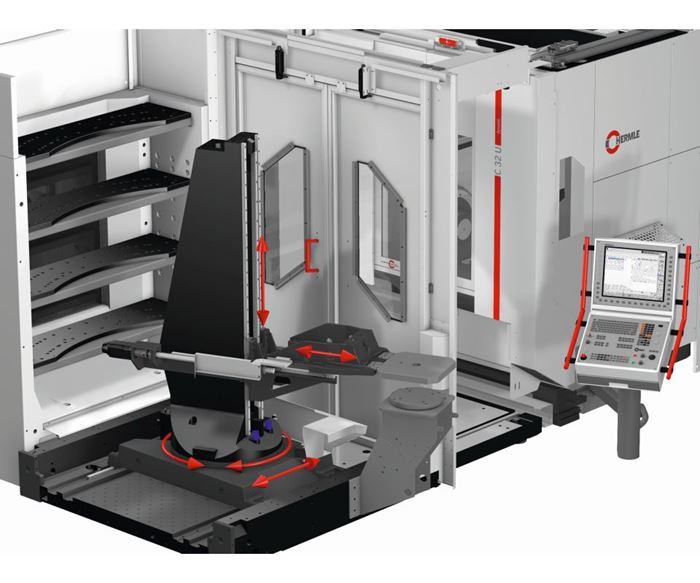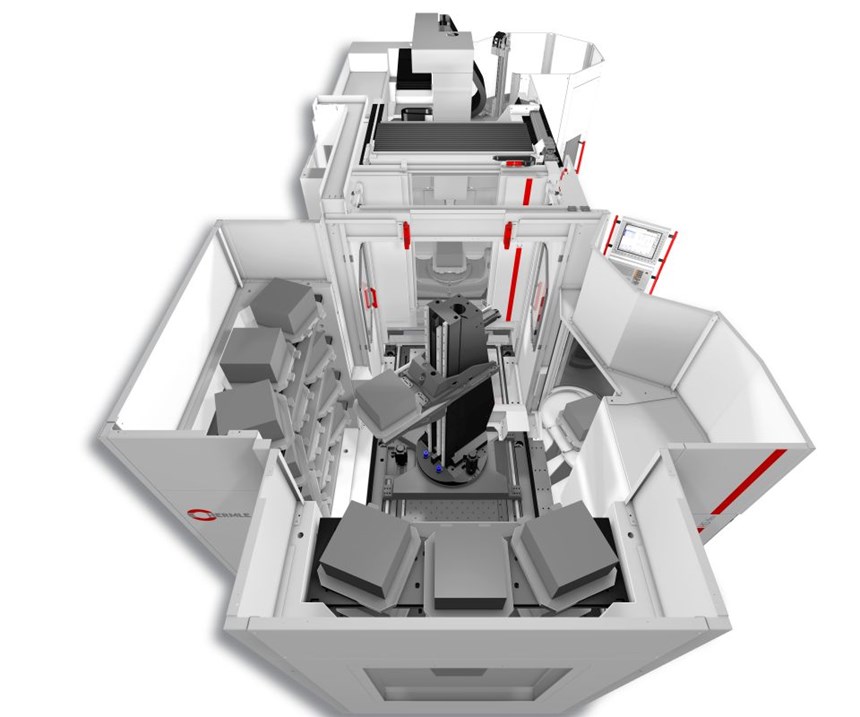Entry-Level Option for Machine Automation
This new modular handling system for Hermle machine tools is designed for shops that don’t necessarily need a complex and expensive robotic system, and it converts stand-alone machines into flexible manufacturing cells.
Machine-tending automation solutions vary in sophistication and price points. In any case, many machine tool builders report an increased interest in automated systems. For example, Franz-Xaver Bernhard, member of the board at Hermle AG in Gosheim, Germany, says the company has been offering both advanced pallet changers and robotic handling systems for many years. It currently sells approximately 20 percent of its milling machines with automation, and the demand is increasing. However, he notes that there are many shops that don’t require such a high-end solution. Some might only need automated machining from time to time and don’t have the budget for an expensive robotic system.
According to Mr. Bernhard, Hermle, known for precise three- and five-axis milling machines, talked to many existing and prospective customers and saw a market for a part-handling system that is competitive with lower-priced systems from third-party suppliers. “There are many advantages to buying automation solutions and machine tools from one source,” he explains. “One of the reasons is safety. If a shop acquires a machine from one supplier and connects an automation system from another, then neither supplier is responsible for the safe operation and compatibility of the two systems. It is the user who has to make sure that all emergency stop systems and so on work.”
This is why the company designed the HS flex handling system, which is available in June, and is based on several components that are delivered as a complete unit. Only the workpiece-storage modules are installed and adjusted at the user’s facility. As a result, the entire installation and machining centers can be completed in a very short time, and the user can start machining with little delay, Mr. Bernhard says.
In contrast to the company’s robot systems, the HS flex is available with a single gripper, but can be expanded to connect two Hermle machines with the HS flex duo (basically two single systems connected between the machines). The HS flex is designed for workpieces weighing as much as 990 pounds and is suitable for Hermle’s High-Performance series C 12, C 22, C 32 and C 42 machines as well as its more affordable, entry-level Performance-Line C 250 and C 400 five-axis machines it recently introduced. (At this stage, the system can only be connected to current machine models due to a lack of compatibility of older CNCs, software and interfaces. However, Hermle is working to make the system compatible with older machine models.)
The HS flex is exclusively made for Hermle machines, which have stable machining beds made from mineral castings. The bed design only allows for front-mounted automation systems, but Hermle has created a flat mineral casting bed onto which the three axes of the handling unit are operated to offer ergonomic access for the operator.
The system’s dual-door design, which has already proven its functional benefits in Hermle’s robot systems, provides a twofold function: It prevents operator access during tool change, and it provides access to the working-view position and working area during machining while also preventing access to the handling unit.
The rotary, lifting and linear axes of the handling unit enable precise movement of heavy workpieces between the setup station, storage modules and the machining center’s working area. It is designed for pallets as large as 19.7 by 15.7 inches. To minimize the sources of potential errors for the operator, the maximum workpiece height is queried beforehand at the setup station, thereby preventing workpieces with dimensions beyond specified dimensions from being fed in.
Hermle has paid particular attention to the development of the storage modules, Mr. Bernhard explains. One module is installed as standard, and an optional second module can be adapted. The modules are structured as a rack, offering customization potential of the pallet/workpiece arrangement. As many as four rack shelves can be ordered with as many as 20 pallet storage spaces per module, providing 40 possible pallet storage spaces when two storage modules are installed. Using a specially developed storage generator, which tests both the permitted weights and dimensions, the storage arrangement can be defined quickly and easily.
The HS flex system is controlled and managed using the proprietary Hermle Automation Control System (HACS). The HACS is said to enable smart order management, which intuitively aids operators in their daily duties via a software solution that can be operated by means of a touch panel. It can also be combined with the Hermle Information Monitoring System, which displays machine status in real time and can be shown on any tablet, smartphone or desktop.
Related Content
An Additive Manufacturing Machine Shop
Finish machining additively manufactured implants requires different pacing and workflow than cutting parts from stock — different enough for an experienced manufacturer to warrant a dedicated machine shop.
Read MoreWhich Approach to Automation Fits Your CNC Machine Tool?
Choosing the right automation to pair with a CNC machine tool cell means weighing various factors, as this fabrication business has learned well.
Read MoreHigh RPM Spindles: 5 Advantages for 5-axis CNC Machines
Explore five crucial ways equipping 5-axis CNC machines with Air Turbine Spindles® can achieve the speeds necessary to overcome manufacturing challenges.
Read MoreHow to Successfully Adopt Five-Axis Machining
While there are many changes to adopt when moving to five-axis, they all compliment the overall goal of better parts through less operations.
Read MoreRead Next
3 Mistakes That Cause CNC Programs to Fail
Despite enhancements to manufacturing technology, there are still issues today that can cause programs to fail. These failures can cause lost time, scrapped parts, damaged machines and even injured operators.
Read MoreThe Cut Scene: The Finer Details of Large-Format Machining
Small details and features can have an outsized impact on large parts, such as Barbco’s collapsible utility drill head.
Read More.jpg;maxWidth=970;quality=90)











.jpg;maxWidth=300;quality=90)





.png;maxWidth=300;quality=90)












.jpg;maxWidth=970;quality=90)